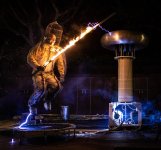just worth mentioning that Japan has the Brown and Asiatic Black Bear, and the black bears there are far more aggressive than the North American Black bear as a species. It's theorized that due to historic competition with aggressive felines like tigers and various other species such as various types of leopards, they've evolved to be highly territorial and confrontational
-
Happy Wright Brothers Day (1903)! 🐱🦅🛩️
You are using an out of date browser. It may not display this or other websites correctly.
You should upgrade or use an alternative browser.
You should upgrade or use an alternative browser.
Fears while paddling or on canoe trips
- Thread starter Glenn MacGrady
- Start date
Back in the seventies I skied up to a boarded up and winterized fire lookout on a peak near Yosemite, and found the plywood had been ripped off a window and the interior ransacked by a bear. Something like those spike panels probably would have stopped that - if it didn't get covered by snow.These two images are from 2001, when Kathleen and I paddled the Snowdrift River, Northwest Territories.
View attachment 150572
Boarded up windows to deter marauding bears,
With heavy-duty spikes on the ground.
View attachment 150573
I don't know about hogs, but it's common for beekeepers with bears in the area to resort to electric fencing. One I know who had a bear raiding his apiary ended that problem with electric fencing. Seems like a lot to carry on a portage though.
UDAP has one that weighs less than 4 pounds (electric fence). One BearVault weighs 2 1/4 pounds.I don't know about hogs, but it's common for beekeepers with bears in the area to resort to electric fencing. One I know who had a bear raiding his apiary ended that problem with electric fencing. Seems like a lot to carry on a portage though.
That's not too bad. Might be worth it in some places.UDAP has one that weighs less than 4 pounds (electric fence). One BearVault weighs 2 1/4 pounds.
If you totally lose all fear it is time to retire from paddling.
My greatest fear has always been the safety of the people that I have invited on overnight trips.
Bears have shown up in camp many times at night. My dogs have always had them leaving on the run. I remember one incident in the day time while portaging an aluminum canoe. The bear took one look at the canoe on my head and left the country.
My greatest fear has always been the safety of the people that I have invited on overnight trips.
Bears have shown up in camp many times at night. My dogs have always had them leaving on the run. I remember one incident in the day time while portaging an aluminum canoe. The bear took one look at the canoe on my head and left the country.
- Joined
- Nov 30, 2017
- Messages
- 1,094
- Reaction score
- 1,500
In one of the books I read this summer, there's the following tale. The author approached a well known canoe explorer and asked if he had ever been afraid during canoe trips. The answer: all the time.
When I come across that again, I'll post it. I'm starting to think it was a book when I was on the Cree. That would narrow it down.
When I come across that again, I'll post it. I'm starting to think it was a book when I was on the Cree. That would narrow it down.
UDAP has one that weighs less than 4 pounds (electric fence). One BearVault weighs 2 1/4 pounds.
It runs on two D cell batteries. How shocking can that be? Especially to a beast covered in thick shag carpet. I'd like to see some proof.
They'll put out 5000 volts. Although I haven't used the UDAP one, battery operated fences are commonly used in grizzly country around food and around game meat, and they're tested and accepted by the Interagency Grizzly Bear Committee (IGBC) as effective deterrents (they represent the industry standard for food storage in grizzly bear habitat--all Federal and most State agencies manage according to their recommendations. See IGBC bear resistance). The IGBC lists requirements of acceptable fences on page 15 (IGBC fences ). Here's a video by the National Outdoor Leadership School on testing fences with grizzly (NOLS fencing). I've seen other vids of bears and fences but I'm sort of lazy this morning (2am my time!).It runs on two D cell batteries. How shocking can that be? Especially to a beast covered in thick shag carpet. I'd like to see some proof.
Improbable as it may sound, it is possible to up transform the puny 3 volts available from a pair of D-cell batteries to any higher voltage you like. It is done with a DC-DC boost converter circuit, which employs inductors, capacitors, diodes, and high-speed electronic switches. (we really need those rare-earth mineral elements). You can get increases and discharges to 5,000 volts, but with very few milliamps from D-cells. A brief discharge of 5,000 volts hurts. Volts hurt and frighten, but it takes a high level of amps (0.1 or more) to kill a human.
A spark discharge after shuffling across a wool rug may generate tens of thousands of painful volts at just a very few milliamps. The voltage needed for a spark in air is approximately 3,000 volts per millimeter. On the other hand, a typical lightning bolt may have a voltage of around 300 million volts and a current of about 30,000 amps.
An imperfect anlogy: Think of high voltage as water pressure from a hole somewhere in a high dam. Amps is the measure of volume of water rushing through due to the size of a hole somewhere in the dam. You can stop most tiny leaks with finger pressure, but a large hole, especially in the high pressure bottom of the dam, will blow you away. A capacitor is the measure of the total volume of water held in the lake behind the dam.
A spark discharge after shuffling across a wool rug may generate tens of thousands of painful volts at just a very few milliamps. The voltage needed for a spark in air is approximately 3,000 volts per millimeter. On the other hand, a typical lightning bolt may have a voltage of around 300 million volts and a current of about 30,000 amps.
An imperfect anlogy: Think of high voltage as water pressure from a hole somewhere in a high dam. Amps is the measure of volume of water rushing through due to the size of a hole somewhere in the dam. You can stop most tiny leaks with finger pressure, but a large hole, especially in the high pressure bottom of the dam, will blow you away. A capacitor is the measure of the total volume of water held in the lake behind the dam.
Last edited:
to put it in a simple layman's term, think of your car or truck- that engine is started initially by the starter solenoid (essentially a switched capacitor) turning a high torque electrical motor which in turn rotates your drive train...
that little 12V capacitor has the juice to overcome the 200+ foot pounds of torque the engine requires to get up to running conditions
that little 12V capacitor has the juice to overcome the 200+ foot pounds of torque the engine requires to get up to running conditions
- Joined
- Aug 10, 2018
- Messages
- 2,047
- Reaction score
- 3,341
Well, THAT might get messy.They'll put out 5000 volts.
Pretty sure the electrocution tongs at the slaughterhouses only use 250 volts for hogs and I think they keel over at pretty low amperages.
On the other hand, maybe we could wake up to freshly roasted pork? That might be nice.
Reminds me of when I was kid, there was a main street corner pharmacy with a soda bar where everyone hung out. They had an electric hot dog cooker. The soda jerk Impaled a dog on one of 6 or 8 rows of pairs of electrode pins. Flip the switch and listen to the steeaming sizzle as high current passed through the meat, done in less than a minute. It made the best tasting hot dog I have ever had to this day. That simple effective dog cooking method was probably later banned for safety reasons.On the other hand, maybe we could wake up to freshly roasted pork? That might be nice.
This is not correct; a starter solenoid is simply a high current relay, used because the keyed starter switch is too small to handle the starting current. It also means the heavy cables don't have to go back into the passenger compartment where the key switch is. The solenoid simply connects the starter to the battery. A capacitor big enough to start a car would be huge.to put it in a simple layman's term, think of your car or truck- that engine is started initially by the starter solenoid (essentially a switched capacitor) turning a high torque electrical motor which in turn rotates your drive train...
that little 12V capacitor has the juice to overcome the 200+ foot pounds of torque the engine requires to get up to running conditions
Capacitors are used in the ignition system for various reasons depending on the type of system (old fashioned points, CDI, etc.)
Here's a video by the National Outdoor Leadership School on testing fences with grizzly (NOLS fencing).
Improbable as it may sound, it is possible to up transform the puny 3 volts available from a pair of D-cell batteries to any higher voltage you like.
Very interesting. Thanks for the further info.
Anyone ever see a Tesla Coil at Burning Man. Blue Lightning going out into space. 10,000 volts but almost no amperage. I guy in a metal suit can arc the juice off the coil onto his body.
- Joined
- Oct 6, 2025
- Messages
- 5
- Reaction score
- 19
I have nowhere near the kind of deep bush experience as some of you....I am in awe, frankly.
Growing up in Montreal,Quebec, I was lucky enough to be a few hours away from wilderness, and got over most irrational fears at a young age. When I had a family of my own, I more or less stopped going into the bush for twenty five years. I started up again when my kids were grown, and had to deal with re-learning a lot of things.
After a decade or so of being back at it, there is very little that I worry about or fear. I am always alone, as I like it that way, so falling and breaking an ankle or leg is something to consider. A couple of aprils ago, I slipped on the only patch of un-melted ice in the entire Canadian shield while portaging a 70 pound canoe on my head. Landed on my face, but learned a lesson. Kevlar is the way to go for an older gentleman. I picked up an old Quessy for $500. At 40 pounds, it works for me.
Not fear so much as concern....
1. Hunters. Hearing the crack of a moose rifle a few hundred yards away tends to focus the mind.
They use heavy artillery. Some of them like to have a drink or two. The older I get, the more I stay out of the bush during cannon season. Same for deer hunters. If I must go fishing/paddling during hunting season, I leave my antler hat at home. No use tempting fate.
2. Crossing large windy lakes. Three or four kilometers across (a couple miles)? Nope.
3. Moose. They are big and stupid, and, if they think you are a threat, can be a bit moody.
4. Habituated black bears. Not because they want to eat me, but, if they are unafraid, there can be a misunderstanding regarding food. I tend to stay away from camp-grounds, so this is somewhat hypothetical.
Real fear:
1. Non habituated black bears. If one comes across a bear that has rarely or never encountered a human, and does not run, it is possible that it has found you deliberately. Unlikely that he is hunting you, but it happens.
In the summer of 1980, at the age of 16, I and two buddies were stalked for twenty four hours by an adolescent bear. I had found an off map brook trout stream deep in the bush (finding these was, and still is, an obsession) and left a stringer with 5 or 6 trout in the water and went for a pee. Upon my return I found several bear tracks where I had been standing moments before. My friends were upstream and I finished up and we climbed up out of the ravine and made our way back to where we would be picked up the next morning, about a day's hike away, using overgrown lumberjack trails, moose trails, and logging roads. I could hear something big every so often in the surrounding forest. I suspected it was the same bear, but was fine with it. The size of the tracks led me to believe that the bear was young and probably defending his territory from a distance. We made camp before dark and I could hear something big circling the campsite all night. I told myself that it was a giant racoon and tried to sleep.
I exited the tent at sunrise and walked directly into what can only be described as a combination of horror and slapstick comedy. A young male, about 250 lbs, 10 feet away from me. Not nearly as cute and cuddly as one would hope, but strikingly beautiful. He had come for the trout, and was in no mood to negotiate. My friends and I got on one side of the tent while the bear was on the other. The bear slowly and silently made his way around the tent as we tried to "scare" it away by shouting and flailing. Apparently this animal did not know the rules and was undeterred. He kept coming and we kept going. At this point we were laughing hysterically, being idiotic teenage males, and the bear seemed almost insulted by this behavior and lunged into the tent opposite us.
Now, one should never run from a bear, right? I ran. We ran. Like a freaking gazelle, I ran. We assembled about a hundred yards away to watch the show. The beast destroyed my nylon three man tent, all of our knapsacks, our shoes, mess kits, and everything else it could find over the next ten minutes.
Then it disappeared into the bush like a ghost. A few minutes later it appeared behind us....Not good. That is when I felt the fear. We changed location. It disappeared and came back behind us....this went on for about a half hour until it finally left. I swear it winked at me and gave me the finger as it went.
I emerged with a pair of Levi's, a T shirt and my old Boy Scout canteen.
2. The Wendigo. The North is lousy with them. From what I hear, they steal your soul and turn you into a cannibal.
Messy business.
Growing up in Montreal,Quebec, I was lucky enough to be a few hours away from wilderness, and got over most irrational fears at a young age. When I had a family of my own, I more or less stopped going into the bush for twenty five years. I started up again when my kids were grown, and had to deal with re-learning a lot of things.
After a decade or so of being back at it, there is very little that I worry about or fear. I am always alone, as I like it that way, so falling and breaking an ankle or leg is something to consider. A couple of aprils ago, I slipped on the only patch of un-melted ice in the entire Canadian shield while portaging a 70 pound canoe on my head. Landed on my face, but learned a lesson. Kevlar is the way to go for an older gentleman. I picked up an old Quessy for $500. At 40 pounds, it works for me.
Not fear so much as concern....
1. Hunters. Hearing the crack of a moose rifle a few hundred yards away tends to focus the mind.
They use heavy artillery. Some of them like to have a drink or two. The older I get, the more I stay out of the bush during cannon season. Same for deer hunters. If I must go fishing/paddling during hunting season, I leave my antler hat at home. No use tempting fate.
2. Crossing large windy lakes. Three or four kilometers across (a couple miles)? Nope.
3. Moose. They are big and stupid, and, if they think you are a threat, can be a bit moody.
4. Habituated black bears. Not because they want to eat me, but, if they are unafraid, there can be a misunderstanding regarding food. I tend to stay away from camp-grounds, so this is somewhat hypothetical.
Real fear:
1. Non habituated black bears. If one comes across a bear that has rarely or never encountered a human, and does not run, it is possible that it has found you deliberately. Unlikely that he is hunting you, but it happens.
In the summer of 1980, at the age of 16, I and two buddies were stalked for twenty four hours by an adolescent bear. I had found an off map brook trout stream deep in the bush (finding these was, and still is, an obsession) and left a stringer with 5 or 6 trout in the water and went for a pee. Upon my return I found several bear tracks where I had been standing moments before. My friends were upstream and I finished up and we climbed up out of the ravine and made our way back to where we would be picked up the next morning, about a day's hike away, using overgrown lumberjack trails, moose trails, and logging roads. I could hear something big every so often in the surrounding forest. I suspected it was the same bear, but was fine with it. The size of the tracks led me to believe that the bear was young and probably defending his territory from a distance. We made camp before dark and I could hear something big circling the campsite all night. I told myself that it was a giant racoon and tried to sleep.
I exited the tent at sunrise and walked directly into what can only be described as a combination of horror and slapstick comedy. A young male, about 250 lbs, 10 feet away from me. Not nearly as cute and cuddly as one would hope, but strikingly beautiful. He had come for the trout, and was in no mood to negotiate. My friends and I got on one side of the tent while the bear was on the other. The bear slowly and silently made his way around the tent as we tried to "scare" it away by shouting and flailing. Apparently this animal did not know the rules and was undeterred. He kept coming and we kept going. At this point we were laughing hysterically, being idiotic teenage males, and the bear seemed almost insulted by this behavior and lunged into the tent opposite us.
Now, one should never run from a bear, right? I ran. We ran. Like a freaking gazelle, I ran. We assembled about a hundred yards away to watch the show. The beast destroyed my nylon three man tent, all of our knapsacks, our shoes, mess kits, and everything else it could find over the next ten minutes.
Then it disappeared into the bush like a ghost. A few minutes later it appeared behind us....Not good. That is when I felt the fear. We changed location. It disappeared and came back behind us....this went on for about a half hour until it finally left. I swear it winked at me and gave me the finger as it went.
I emerged with a pair of Levi's, a T shirt and my old Boy Scout canteen.
2. The Wendigo. The North is lousy with them. From what I hear, they steal your soul and turn you into a cannibal.
Messy business.
Getting severely polluted water in my mouth or eyes. I’d love to get back to worriying about big windy wild lakes.
Similar threads
- Replies
- 59
- Views
- 7K
- Replies
- 80
- Views
- 8K




